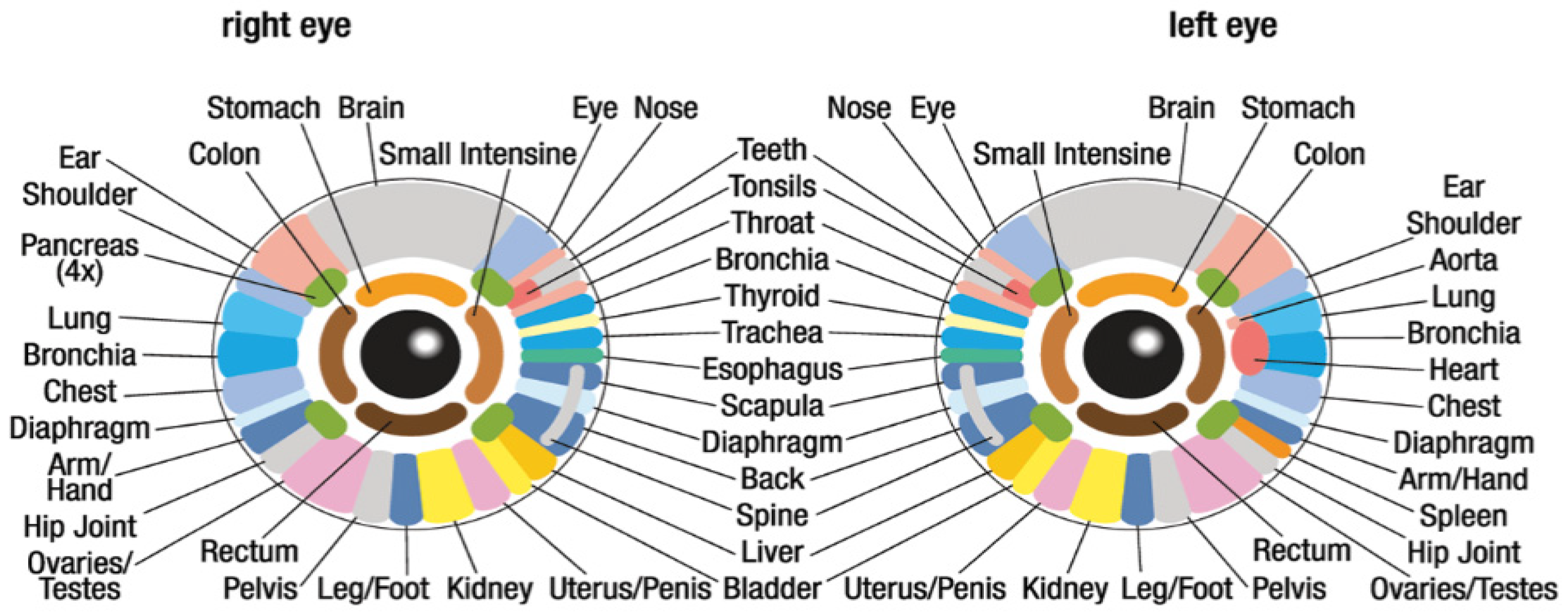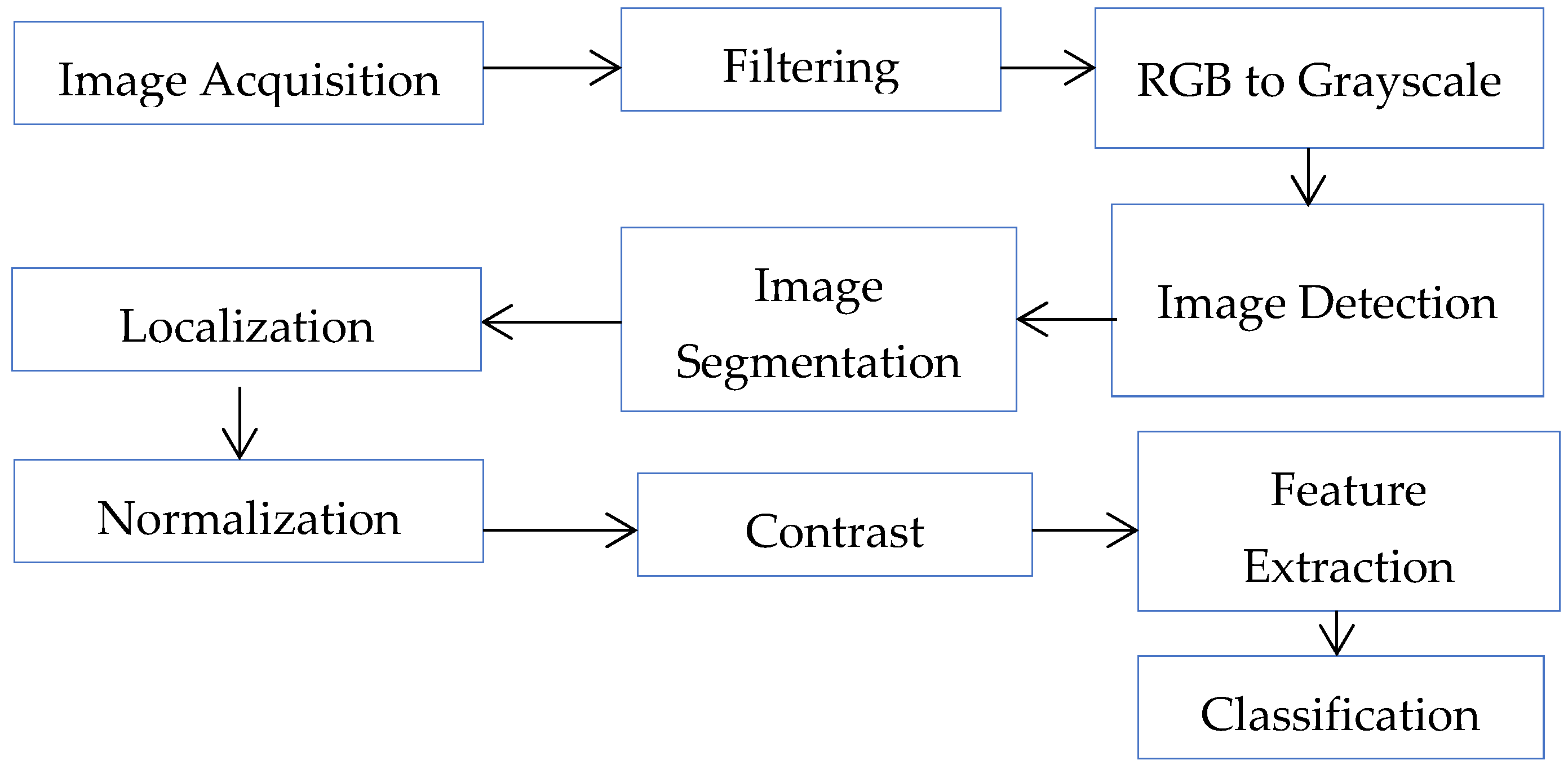A Methodical Review of Iridology-Based Computer-Aided Organ Status Assessment Techniques †
Abstract
:1. Introduction
1.1. Overview of Iridology
1.2. Challenges
- i.
- The notion that a person’s iris may be utilized to identify particular medical disorders is unsupported by scientific research.
- ii.
- Iridology chart reading is a subjective process that varies from practitioner to practitioner.
- iii.
- It might be challenging to spot the small changes in the iris that are allegedly linked to health issues.
- iv.
- Even seasoned iridologists make imprecise diagnoses.
2. Materials
- i.
- Patients’ medical histories, lab results, and all other diagnostic information included in patient records.
- ii.
- Various tools, such as digital cameras, slit lamps, and fundus cameras, were used to take iris images.
- iii.
- Genetic information: this includes details about the patient’s DNA that could be used to pinpoint genetic risk factors for particular diseases.
3. Methodology
3.1. Image Pre-Processing
3.2. Filtering an Image
3.3. RGB to Grayscale
3.4. Image Detection
3.5. Image Segmentation
3.6. Localization
3.7. Normalization
3.8. Contrast Enhancement
3.9. Feature Extraction
3.10. Constructing a Model
3.11. Limitations
4. Conclusions
Author Contributions
Funding
Institutional Review Board Statement
Informed Consent Statement
Data Availability Statement
Acknowledgments
Conflicts of Interest
References
- Aminah, R.; Saputro, A.H. Application of machine learning techniques for diagnosis of diabetes based on iridology. In Proceedings of the 2019 International Conference on Advanced Computer Science and Information Systems (ICACSIS), Bali, Indonesia, 12–13 October 2019; pp. 133–138. [Google Scholar]
- Barden, A. Can Iridology Really Detect Health Conditions by Analyzing the Iris? Available online: https://www.allaboutvision.com/eye-care/eye-exams/what-is-iridology/ (accessed on 2 November 2023).
- Esteves, R.B.l.; Morero, J.A.; de Souza Pereira, S.; Mendes, K.D.; Hegadoren, K.M.; Cardoso, L. Parameters to increase the quality of iridology studies: A scoping review. Eur. J. Integr. Med. 2021, 43, 101311. [Google Scholar]
- Simon, A.; Worthen, D.M.; Mitas, J.A. An evaluation of iridology. Jama 1979, 242, 1385–1389. [Google Scholar]
- Ramlee, R.A.; Ranjit, S. Using iris recognition algorithm, detecting cholesterol presence. In Proceedings of the 2009 International Conference on Information Management and Engineering, Kuala Lumpur, Malaysia, 3–5 April 2009; pp. 714–717. [Google Scholar]
- Permatasari, L.I.; Novianty, A.; Purboyo, T.W. Heart disorder detection based on computerized iridology using support vector machine. In Proceedings of the 2016 International Conference on Control, Electronics, Renewable Energy and Communications (ICCEREC), Bandung, Indonesia, 13–15 September 2016; Volume 13, pp. 157–161. [Google Scholar]
- Crone, S.F.; Lessmann, S.; Stahlbock, R. The impact of preprocessing on data mining: An evaluation of classifier sensitivity in direct marketing. Eur. J. Oper. Res. 2006, 173, 781–800. [Google Scholar]
- Singh, B.K.; Verma, K.; Thoke, A.S. Investigations on impact of feature normalization techniques on classifier’s performance in breast tumor classification. Int. J. Comput. Appl. 2015, 116, 11–15. [Google Scholar]
- Discovering Informative Regions in Iris Images to Predict Diabetes. Available online: https://github.com/NaghmeNazer/diabetes-iridology/tree/master (accessed on 2 November 2023).
- El-Sisi, H.O.; El-Gamal, F.E.; Hikal, N.A. Iridology-Based Human Health Examination. In Proceedings of the 2021 17th International Computer Engineering Conference (ICENCO), Cairo, Egypt, 29–30 December 2021; pp. 7–13. [Google Scholar]
- Ilin, R.; Watson, T.; Kozma, R. Abstraction hierarchy in deep learning neural networks. In Proceedings of the 2017 International Joint Conference on Neural Networks (IJCNN) 2017, Anchorage, AK, USA, 14–19 May 2017; pp. 768–774. [Google Scholar]
- Buchanan, T.J.; Sutherland, C.J.; Strettle, R.J.; Terrell, T.J.; Pewsey, A. An investigation of the relationship between anatomical features in the iris and systemic disease, with reference to iridology. Complement. Ther. Med. 1996, 4, 98–102. [Google Scholar]
- Donoghue, S. Modern Iridology: A Holistic Guide to Reading the Eyes; Aeon Books: Columbia, MD, USA, 2023. [Google Scholar]
- Sruthi, K.; Vijayakumar, J.; Thavamani, S. Deep Learning-Based Verification of Iridology in Diagnosing Type II Diabetes Mellitus. Int. J. Pattern Recognit. Artif. Intell. 2022, 36, 2252017. [Google Scholar]
- Alshdaifat, E.A.; Alshdaifat, D.A.; Alsarhan, A.; Hussein, F.; El-Salhi, S.M.D.F.S. The Effect of Preprocessing Techniques, Applied to Numeric Features, on Classification Algorithms. Performance 2022, 6, 11. [Google Scholar]
- Önal, M.N.; Güraksin, G.E.; Duman, R. Convolutional neural network-based diabetes diagnostic system via iridology technique. Multimed. Tools Appl. 2023, 82, 173–194. [Google Scholar]
- Rende, U.; Guller, A.; Goldys, E.M.; Pollock, C.; Saad, S. Diagnostic and prognostic biomarkers for tubulointerstitial fibrosis. J. Physiol. 2023, 601, 2801–2826. [Google Scholar]
- Özbilgin, F.; Kurnaz, Ç.; Aydın, E. Prediction of Coronary Artery Disease Using Machine Learning Techniques with Iris Analysis. Diagnostics 2023, 13, 1081. [Google Scholar]
- Perner, P. IRIS acquisition and detection for computer-assisted iridiology. In Proceedings of the 22nd Signal Processing and Communications Applications Conference, SIU 2014—Proceedings, Trabzon, Turkey, 23–25 April 2014; pp. 2291–2295. [Google Scholar]
- Lekarskie, W. Iridiology and Iridodiagnostics. Wiad. Lek. 1984, 37, 163–167. [Google Scholar]


| Year | Data-Collection Device | Resolution |
|---|---|---|
| 2023 | Nikon D3300 DSLR camera | 6000 × 4000 |
| 2022 | Digital Camera | 0–255 pixels |
| 2020 | Slit lamp device | - |
| 2019 | 12.8-megapixel back-illuminated camera | - |
| 2018 | Digital camera (1.75 m pixel resolution, 0.5 × digital zoom, and LED flash) | - |
| Year | Image Pre-Processing | Feature Extraction | Data Source | Total Data Used | Accuracy % | |
|---|---|---|---|---|---|---|
| 2023 | Iris localization—Daugman’s Integral D | Discrete Wavelet Transform (DWT) | Nikon D3300 | 198 | 104—Normal | 93 |
| DSLR camera | 94—Abnormal | |||||
| 2022 | Filtering—Gaussian filter | GLCM | India Institute Delhi Database (IITD) | 50 | 27—Normal | 95.96 |
| 23—Abnormal | ||||||
| 2022 | RGB to Gary scale | GLCM | Digital camera | 250 | 125—Normal | Linear—87 |
| Edge detection and Circle Hough Transform | ||||||
| Normalization | Polynomial kernal—89 | |||||
| 125—Abnormal | Gaussian kernel—91 | |||||
| 2020 | Daugman’s circular edge detection operator | GLCM | Slit lamp device | 40 | 15—Normal | 81 |
| 25—Abnormal | ||||||
| 2019 | CLAHE | PCA | From the previous researcher | 110 | 55—Normal | 95.45 |
| 55—Abnormal | ||||||
| 2018 | CLAHE | PCA | From the previous researcher | 90 | 40—Normal | PCA—90 |
| GLCM | 50—Abnormal | GLCM—77.5 | ||||
| 2018 | CLAHE | PCA | 90 | 92.5 | ||
Disclaimer/Publisher’s Note: The statements, opinions and data contained in all publications are solely those of the individual author(s) and contributor(s) and not of MDPI and/or the editor(s). MDPI and/or the editor(s) disclaim responsibility for any injury to people or property resulting from any ideas, methods, instructions or products referred to in the content. |
© 2023 by the authors. Licensee MDPI, Basel, Switzerland. This article is an open access article distributed under the terms and conditions of the Creative Commons Attribution (CC BY) license (https://creativecommons.org/licenses/by/4.0/).
Share and Cite
Alphonse, S.; Venkatesan, R.; Jebaseeli, T.J. A Methodical Review of Iridology-Based Computer-Aided Organ Status Assessment Techniques. Eng. Proc. 2023, 59, 9. https://doi.org/10.3390/engproc2023059009
Alphonse S, Venkatesan R, Jebaseeli TJ. A Methodical Review of Iridology-Based Computer-Aided Organ Status Assessment Techniques. Engineering Proceedings. 2023; 59(1):9. https://doi.org/10.3390/engproc2023059009
Chicago/Turabian StyleAlphonse, Suja, Ramachandran Venkatesan, and Theena Jemima Jebaseeli. 2023. "A Methodical Review of Iridology-Based Computer-Aided Organ Status Assessment Techniques" Engineering Proceedings 59, no. 1: 9. https://doi.org/10.3390/engproc2023059009
APA StyleAlphonse, S., Venkatesan, R., & Jebaseeli, T. J. (2023). A Methodical Review of Iridology-Based Computer-Aided Organ Status Assessment Techniques. Engineering Proceedings, 59(1), 9. https://doi.org/10.3390/engproc2023059009





